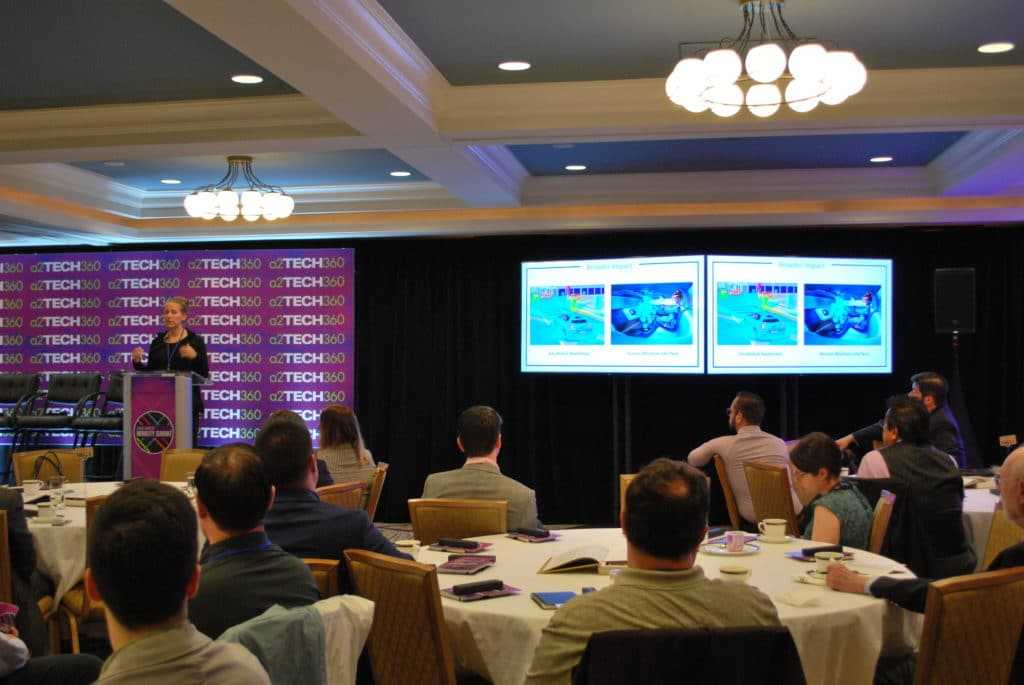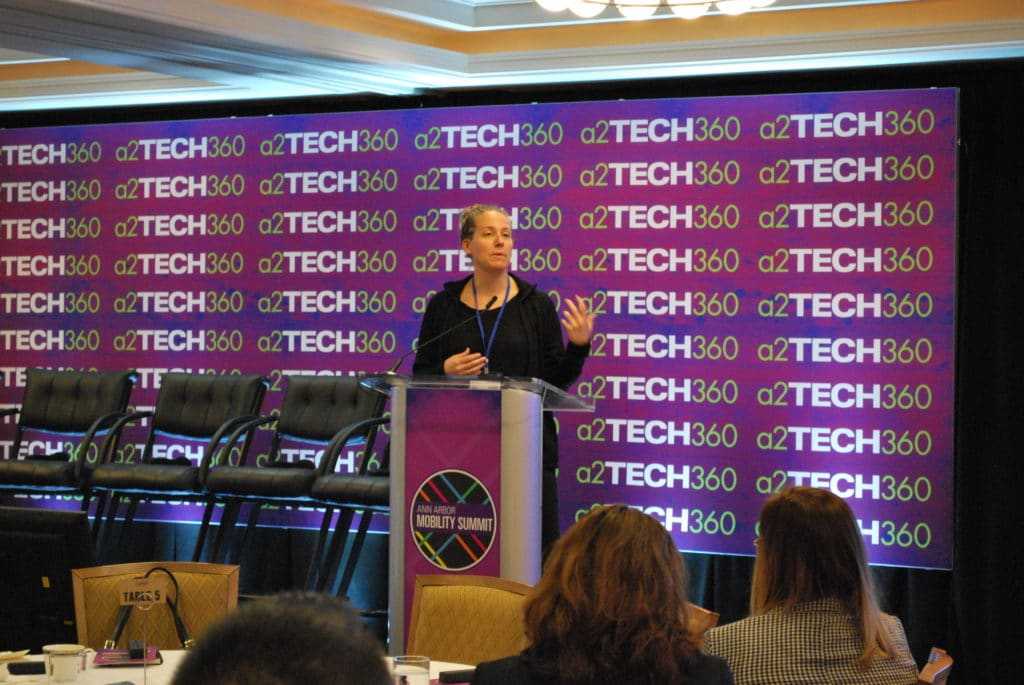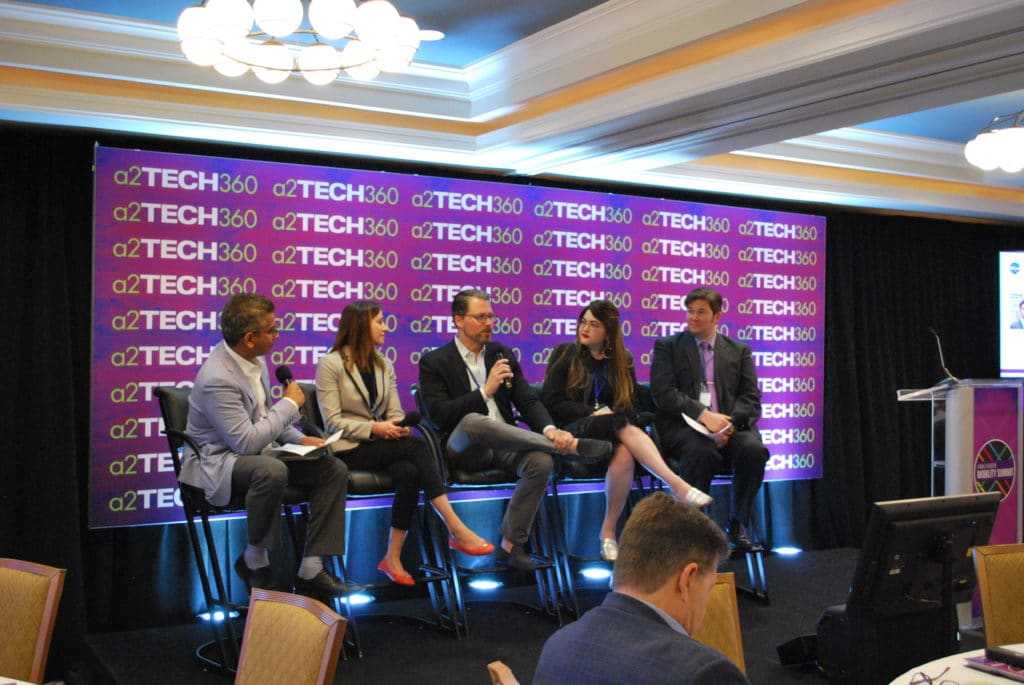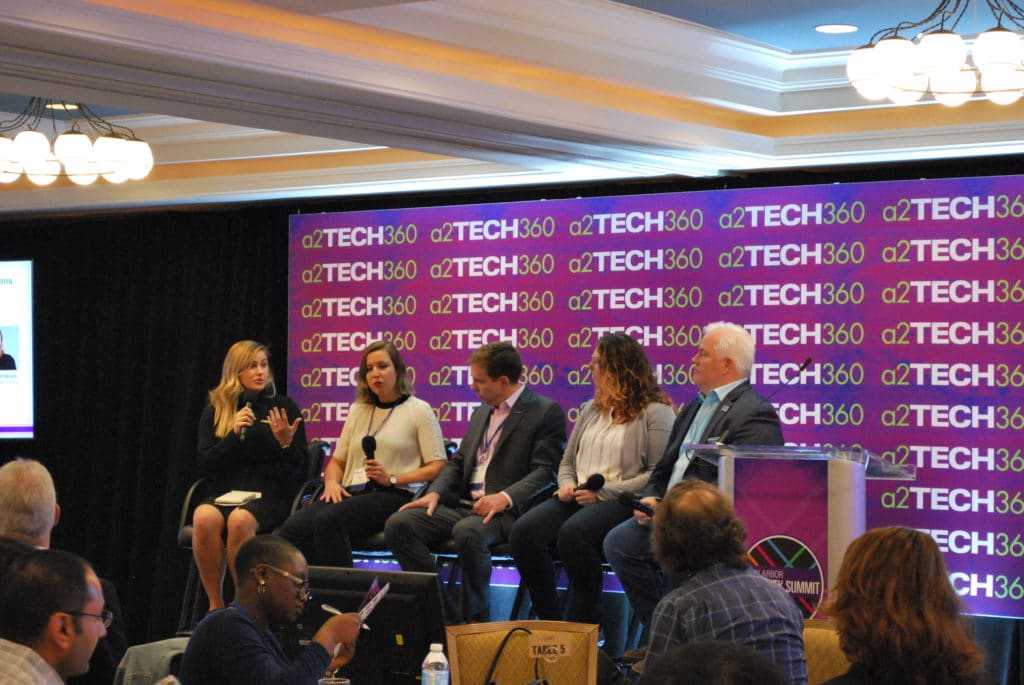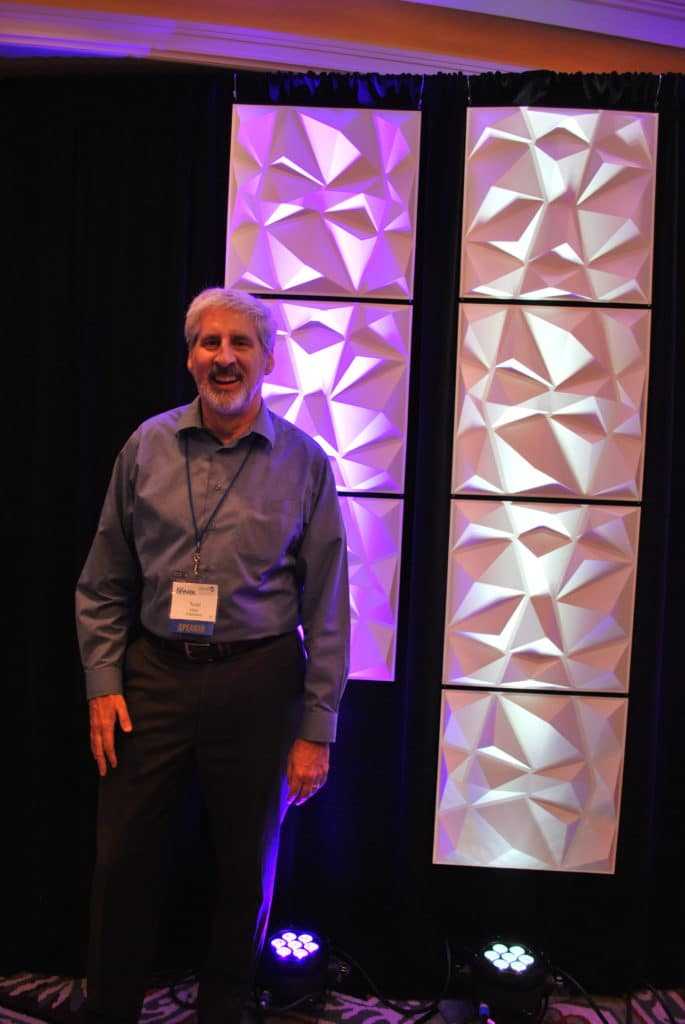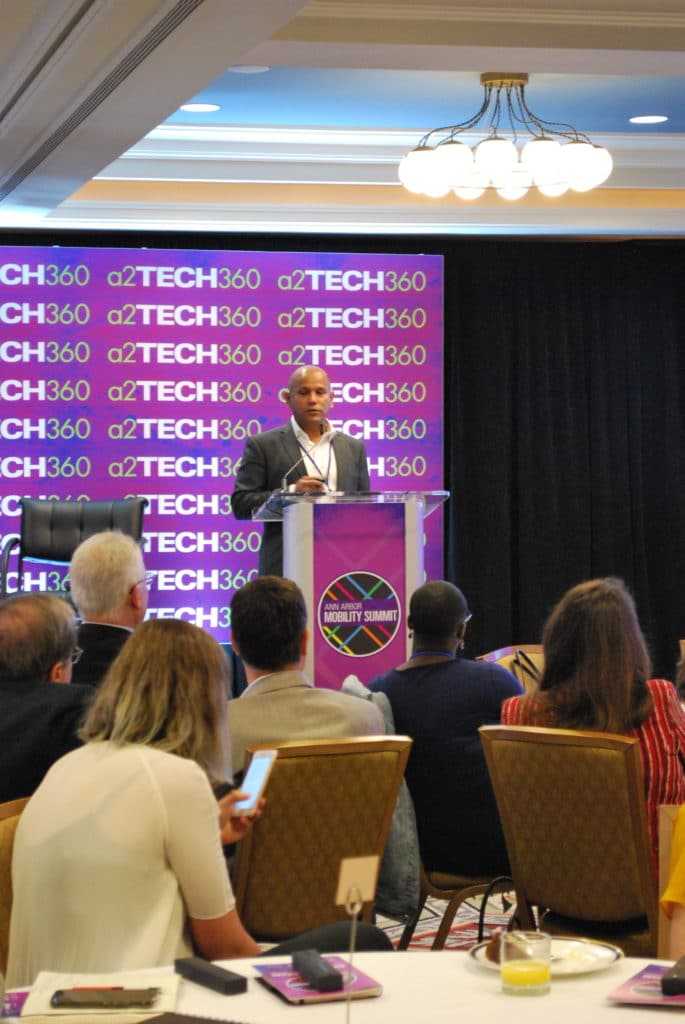Ann Arbor Mobility Summit 2019
By Laura Cowan
Laura K. Cowan is a tech, business, and wellness journalist and fantasy author whose work has focused on promoting sustainability initiatives and helping individuals find a sense of connection with the natural world.
-
Kira Barton of S3D Precision Dispensing talks about how the company's new technology in printing flexible circuits is revolutionizing in-vehicle sensing.
-
Maya Pindeus of Humanising Autonomy says the company is running a pilot in Ann Arbor to monitor and understand driver behavior.
“People used to drive for fun. It’s not fun anymore. It’s not working,” said John Tolva the founder of Cityfi at the opening of the a2Tech360 Mobility Summit at The Graduate hotel on Huron Street in Ann Arbor. Americans spend 75 minutes a day on daily trips, he said, and we know that cycling to work reduces the risk of dying 45% over driving or using public transport, but the truth is, ridesharing that can be a positive individual experience doesn’t scale. This is because mobility isn’t just about saving time. How does it feel?
Speaker Todd Olsen is an old acquaintance, formerly of Ford finance and now running P3 Mobility.
S3D Precision Dispensing Chief Science Officer Kira Barton introduced the company’s 3D printed flexible sensors, which could revolutionize in-vehicle sensing because they have the unique ability to be printed onto any surface such as seats, steering wheels, and even antennas. “As we transition to more autonomy there are 2 critical pieces needed to enable this,” she said. “Situational awareness, and human-machine interfaces.” The industry needs 10 times the sensing in vehicles than is available today, Barton said, “so we’re seeing a move toward printed electronic pieces onto component.” These sensors are designed to sense and give info back.
Bedestrian’s Shadi Mere said that mobility isn’t about moving people, either. “It’s about equitable access as well and about bringing things to people,” he said. That’s because a large portion of the population is now aiming to age in place. Services such as pharmacy automated delivery are now the focus of companies like Bedestrian, which is working to overcome the challenges of access and mobility using robots that are now being piloted at Beaumont Hospital to deliver prescriptions to patients and interact with staff. The obstacles to this technology working are that robots have to know how to navigate busy pedestrian environments safely when the people around them are often distracted (on their phones, for example). These robots also have to communicate with people even when not connected to the cloud.
Andy Palanisamy of Ford Smart Mobility talks at the Mobility Summit about data that drives decision making in mobility.
Data collection and analysis was a theme in many talks regarding how public and private partnerships inform decisions on how to plan mobility infrastructures for Ann Arbor and the region. “Everyone can tell wrangling data is a complex project and as you can see I don’t have any hair left,” Andy Palanisamy of Ford Smart Mobility laughed. A panel on Ann Arbor’s Mobility Data Platform concurred. Mouchka Heller of the World Economic Forum said she was in town ready to judge the Detroit area since she brings a New York-Parisian perspective on mobility issues, but, she said, she was inspired by the passion and faith here in the region and the love for Detroit as well as mobility technology. She emphasized the importance of partnerships across the public-private divide, which can be difficult to navigate politically. “Even collectively we don’t know everything,” she said. “But every person has unique abilities” that can inform the collective effort to invent the future of mobility, which we really don’t know where it’s going yet, because it hasn’t happened and is being created at a historic rate.
“We need a new kind of engineer, a mobility engineer,” Chris Thomas of the Detroit Mobility Lab said. He has worked to create new programs in Master in Mobility, introduced at last year’s NAIAS in Detroit, to help create a unique university research corridor partnership with industry that will create a new career for automotive engineers and other related professionals that didn’t exist before. “We have to own that here,” he said. “Before the invention of automotive, there was no automotive engineer. Before aviation, there was no aviation engineer.”
A media professional in the room from China, who grew up in automotive but worked in Silicon Valley for years, expressed concern during a networking break about the lack of urgency in Detroit and the lack of funding compared to the Valley. Also, Detroit car guys are focused on hardware, he said. Not user experience. These are all valid (and urgent) criticisms, however, we have learned from working in Detroit for years, where no one will tell you what they’re working on to address current challenges that aren’t ready for primetime or what their OEM partnerships are, that Detroit is slow and a bit bogged down by legacy culture, but is always working behind the scenes, especially these days on user experience and in-vehicle software and sensing technology. We will see. Just as it is difficult for Detroit companies to adapt to Valley culture, it is equally difficult for Valley companies to connect into the automotive networks without old money Detroit partnerships, which shuts them out of engineering talent, hardware expertise, and manufacturing know-how.
Panelist Chris Thomas of Detroit Mobility Lab talks about how the mobility industry and Detroit region needs a new kind of engineer specializing in mobility technology, which goes far beyond automotive alone.
Glenn Stevens of MICHauto said he spoke recently to the CEO of Harman at the Detroit Economic Club about what Detroit can do to ensure they have ownership of the future of mobility. “Own an army of young minds,” he replied, “and develop an ecosystem for startups.” This is famously slow and difficult on both fronts in a region dealing with manufacturing decline and brain drain, though the situation is improving thanks to efforts of people like Stevens, who helped found Planet M Landing Zone for new companies. The space is now an accelerator hub for nearly 60 companies and looking to see how they can grow out from there.
It’s not a misuse of the term ironic that we missed half a panel to move a car from a time-limited space three blocks away because The Graduate is one of the least accessible sites in town mobility-wise. There was a certain quiet skepticism in private conversations around the room about how quickly cities like Ann Arbor would create livable mobility plans when they are still working on plans they had 10 years ago and the SE Michigan region failed to pass millage for regional light rail. Nevertheless, one entrepreneur after another stood up to highlight their company’s unique offerings and pilot programs for self-driving vehicles, smart roads, ridesharing programs, and more around Ann Arbor. Todd Olsen of P3 Mobility said they’re very focused on customer data privacy to build out an ecosystem that’s advantageous and safe for everyone. Greg McGuire of MCity said they have been piloting self-driving transport programs out of the old Pfizer research complex on the north side of town. “It looks like a service but functions as a research project,” he said. Julia Roberts of the AATA bus system in Ann Arbor said they recently explored automated technology for wheelchair securements on 10 buses, one tenth of their fleet, to look at ways they could improve efficiency of current offerings.
“Data is the new oil, no it’s the new bacon because it has a shelf life,” several speakers bantered. Data is what’s driving these efforts to pilot new forms of mobility and accessibility. Angela Ayers of Ford Smart Mobility said that it’s valuable to take not only current real-time data now available but also historical data to inform better decisions about how to patch holes in transportation and mobility systems in cities. Raymon Hess from the City of Ann Arbor agreed, while admitting the city was still working on transportation plans from 2009. “We have new tools and new partners now,” he said. “Big data allows us to achieve goals more efficiently and be smarter about what we do. We can measure things better, [find gaps] and create better mobility solutions.”
Speakers such as Mouchka Heller, Seung-Woo Seo of ThorDrive, and others came to the Mobility Summit from around the world. It was nice perspective on what many people think of traditionally as a local economy because of Detroit’s history as the birthplace of automotive and mobility. Most everyone agreed, however, that to maintain Detroit’s legacy of leadership as transportation expands to a larger autonomized mobility market, many partnerships across the globe will be necessary to make the most of available expertise and to avoid reinventing the wheel in multiple locations. “Many cities across the world are looking at the same issues,” Mouchka Heller said. “These are ultimately the same problems, the same human needs.”

